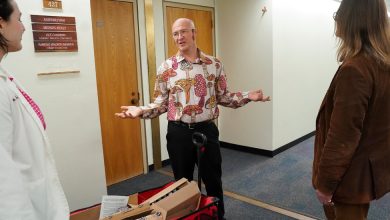This War Did Not Start a Month Ago

For the past month, normal life in Ramallah — a city in the West Bank usually known for its young population and its vibrant nightlife — has been brought to a standstill.
Since Hamas’s deadly Oct. 7 attacks, Israeli forces have launched numerous raids on the West Bank, arresting people from all walks of life: students, activists, journalists, even individuals posting online in support of Gaza. Air and drone strikes have destroyed houses and streets, targeted numerous refugee camps, and nearly leveled Al-Ansar Mosque.They have pummeled the city of Jenin; last month, Israeli forces destroyedthe memorial for an Al Jazeera journalist, Shireen Abu Akleh, at the spot where she was killed while reportingmore than a year ago.
Meanwhile, a settlement council has been distributing hundreds of assault rifles to civilian squads in settlements in the northern West Bank part of a larger effort by National Security Minister Itamar Ben-Gvir, who is a settler himself, to arm civilian groups in the wake of the Oct. 7 attacks. So far, the ministry has purchased 10,000 assault rifles for such teams around the country. It’s part of the atmosphere of escalating violence that has killed more than 130 Palestinians living in the West Bank since Oct. 7.
For Palestinians, this type of systematic violence is nothing new.
To many inside and outside this war, the brutality of Hamas’s Oct. 7 attacks was unthinkable, as has been the scale and ferocity of Israel’s reprisal. But Palestinians have been subject to a steady stream of unfathomable violence — as well as the creeping annexation of their land by Israel and Israeli settlers — for generations.
If people are going to understand this latest conflict and see a path forward for everyone, we need to be more honest, nuanced and comprehensive about the recent decades of history in Gaza, Israel and the West Bank, particularly the impact of occupation and violence on the Palestinians. This story is measured in decades, not weeks; it is not one war, but a continuum of destruction, revenge and trauma.
Since the 1948 Nakba — in which entire Palestinian villages were wiped off the map and the modern state of Israel was established — Palestinians have endured a subjugation that has defined their daily lives. For decades, we have been reeling from Israel’s military occupation, as well as a succession of deadly invasions and wars. The wars of 1967 and 1973 helped shape the modern geography and geopolitics of the area, with millions of largely stateless Palestinians split between Gaza and the West Bank. In Gaza, often referred to as the world’s largest open-air prison, Palestinians are prohibited from entering or leaving, except in incredibly rare circumstances.
This history has been absent from much of the discourse surrounding the Israel-Hamas war, as though the attacks of Oct. 7 were completely arbitrary. The truth is, even in times of relative peace, Palestinians are second-class citizens in Israel — if they are deemed citizens at all. According to Israeli law, Palestinians do not have the right to national self-determination, which is reserved for Jewish citizens of the state. A variety of laws restrict Palestinians’ right to movement, governing everything from where they can live to what personal identifications they can hold to whether or not they can visit family members elsewhere.
The “right of return” —the right of Palestinians and their descendants to return to villages they were ethnically cleansed from during the 1948 war — is central to many Palestinians’ political perspective because so many are still, legally, refugees. In Gaza, for instance, roughly two-thirds of the population consists of refugees. This status is not some abstraction; it dictates everything from where people live to what schools they go to or doctors they see.
Many Gazans have parents and grandparents who grew up only a few miles from where they live now, in areas they are now, of course, forbidden to enter. They still invoke rich memories from their childhood or adolescence, when they walked through citrus groves in Yaffa or olive fields in Qumya — the latter of which, like many villages whose people were expelled into Gaza during the 1948 war, was later transformed into a kibbutz.
There have been periods of increased cooperation between Israelis and Palestinians over the past 75 years. But these were usually preceded by times of increased conflict, such as the first and second intifadas, or popular uprisings. The intifadas, in which Palestinians participated in large-scale resistance, sometimes civil and sometimes violent, are often presented by Western media as random or indiscriminate bursts of murderous savagery — as has been the case with the Oct. 7 attacks. But that violence did not happen in a vacuum.
Stark conditions in Palestinian communities — including the ever-tightening control of daily life through violent night raids, arrests, military checkpoints and the building of illegal Israeli settlements — were the backdrop to these outbursts. Unfortunately, from a historical standpoint, these acts of violence seem to be the only things that have moved the needle politically for Palestinians.
The death and destruction we Palestinians have collectively witnessed and endured has prolonged our generational trauma. Even before this conflict, PTSD was a mainstay in Palestinian homes, as was depression. As a young population, children bear the brunt of Israel’s military rule: Many are snatched at night from their beds or from the arms of their mothers, beaten and imprisoned after being tried arbitrarily in military courts. Others are shot and paralyzed, if not killed.
In Gaza, these victims have virtually no legal possibility of recourse from the Israeli state. Under the 16-year siege of Gaza, Israeli administrators have controlled access to electricity, food and water, at one point determining the number of calories Gazans could consume before sliding into malnutrition. They have also allowed Gaza and the occupied territories to serve as a testing ground for Israel’s vaunted security tech firms. Many people from Gaza have risked the perilous journey across the Mediterranean to get out, only to die en route.
With Gaza sealed for the past 16 years, and the West Bank largely contained by settler violence and the army, Israel has been able to keep its occupation indefinite. The periodic spasms of violence — such as the occasional small group or lone wolf attacks and rocket barrages — reinforce the state’s justification for long-term control of Palestinians and Palestinian lands.
Over the years, Prime Minister Benjamin Netanyahu and his advisers have been very clear that a separate, sovereign Palestinian state is not on the negotiating table. Neither is the possibility of giving Palestinians the rights that Israelis enjoy. So the status quo of endless occupation — and regular cycles of violence — have become normalized, with the international community seemingly unwilling or unable to hold Israel’s government to account.
The Oct. 7 attacks broke that state of play. The occupation’s unsustainable nature was laid bare for all to see, as was the impossibility of governing two peoples but privileging one of them over the other.
Dark days are ahead — that much we know. Having lived through wars, invasions and bombardments, we have come to expect the worst. In the West Bank, morale is low on the quiet streets. Twenty-four-hour Arabic satellite news stations provide a droning, ubiquitous background to daily life. They play a constant stream of horrific images and videos: all shocking, but not unprecedented.
A feeling of helplessness permeates the West Bank’s cities and villages as we watch more and more fellow Palestinians — now more than 11,100, according to the Gazan health ministry — lose their lives. Israeli officials have proposed pushing Gaza’s population into Egypt’s Sinai Desert, which would render them refugees twice or three times over, and perhaps edge the Israeli settler project into a new, more expansive phase. In the West Bank, we look around, and wonder: Could it happen here? Is it happening already?
Any kind of shared future is most likely a longer way off than it was a month ago. But Palestinians already knew that. Was the day before Hamas’s attacks considered “peace”? Maybe for Israelis it was, but for Palestinians it wasn’t.
Dalia Hatuqa is an independent journalist specializing in Palestinian-Israeli affairs.
The Times is committed to publishing a diversity of letters to the editor. We’d like to hear what you think about this or any of our articles. Here are some tips. And here’s our email: [email protected].
Follow The New York Times Opinion section on Facebook, Twitter (@NYTopinion) and Instagram.



